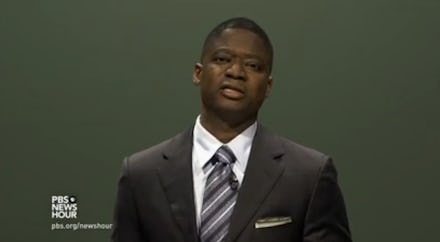Law Professor Highlights Big Double Standard in How We Treat Opioid Versus Crack Addiction

America wasn't ready for crack cocaine.
When the drug started tearing through poor neighborhoods in the 1980s, politicians and law enforcement officials responded by escalating the war on drugs, demonizing addicts and molding terms like "crack baby" and "super predator" into the stuff of American nightmares.
Now there's a new "epidemic" sweeping the nation: opioid addiction. But according to critics and legal experts, the response this time has been remarkably different.
Ekow Yankah says the biggest factor is racism. In a video essay recorded Tuesday for PBS NewsHour, the law school professor at Yeshiva University in New York explained how America's newfound compassion for addicts stems from today's epidemic affecting mostly white victims.
"When addiction was a black problem, there was no wave of national compassion," Yankah said. "Instead, we were warned of 'super predators,' young, faceless black men wearing bandanas and sagging jeans."
"African-Americans were cast as pathological," he said. "Their plight was evidence of collective moral failure, of welfare mothers and rock-slinging thugs and a reason to cut off all help."
"Blacks would just have to pull themselves out of the crack epidemic," he said. "Until then, the only answer lay in cordoning off the wreckage with militarized policing."
Yankah went on to describe how today's response to opioid abuse, in contrast, is marked by a growing movement to decriminalize and treat it for what it is: a public health issue.
Here is a transcript of an excerpt — titled, "There was no wave of compassion when addicts were hooked on crack" — via PBS:
That Kroger, the Midwestern grocery chain, has decided to make the heroin overdose drug naloxone available without a prescription is a sign of how ominous the current epidemic has grown.
A number of developments in drug addiction treatment have rocked the United States in recent months. The Obama administration announced Tuesday a new initiative to fight opioid abuse, which included expanding the availability of anti-addiction pharmaceuticals.
He is not alone: Pharmacies in some states — including, most recently, Ohio — have made the "heroin antidote" naloxone available for purchase over the counter. This new approach is seen as a response to the demographic shift in addiction today. According to the New York Times, 90% of people who tried heroin for the first time in the last decade were white.
"[The] growing army of families of those lost to heroin — many of them in the suburbs and small towns — are now using their influence, anger and grief to cushion the country's approach to drugs, from altering the language around addiction to prodding government to treat it not as a crime, but as a disease," wrote the Times of this new, whiter face of the drug epidemic.
The tenor of the conversation has certainly shifted since the 1980s. If only addiction's black victims had been treated with the same compassion as white victims today, who knows how much closer to a common sense drug policy we'd be.
h/t PBS